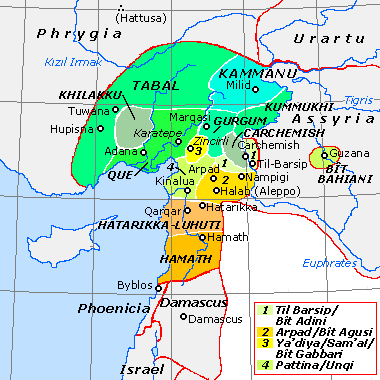Bit Agusi

Bit Agusi or Bit Agushi (also written Bet Agus) was an ancient Aramaean
Chronology
According to Dan'el Kahn, there were seven stages of Bit Agusi history in Northern Syria in the ninth and eighth centuries BC.[4]
- Stage 1 (858–ca. 842 BC). Early on, Bit Agusi was apparently free of political alliances with neighbors. Arame, the second king of Bit Agusi, submitted to Assyria freely in 858 BCE, along with many other rulers of the region, including the southern Anatolia.
- Stage 2 (841–823 BC). A period of Bit Agusi subjugation to Assyria.
- Stage 3. Around 823 BC, or maybe a little later, Bit Agusi leads a local alliance opposing Assyrian hegemony, and achieves independence.
- Stage 4. Also, soon after this time Aram-Damascus becomes supreme in the region; this lasted until some time before 805 BC. Hazael, King of Aram-Damascus was prominent.
- Stage 5 (ca. 800–754 BC). This is the time when the Kingdom of Luash arose in the south, while Urartubecame prominent in the north. Assyria was weaker at this time.
- Stage 6 (754–744 BC). At this time, Bit Agusi (now known as the Kingdom of Arpad) rose to prominence and probably controlled Hamath, or was in a close confederation with it. Also, the Attarsumki, King of Arpad.
- Stage 7 (743–740 BC). Bit Agusi is reduced to the status of an Assyrian province.
The identity of Bar-Gayah, King of KTK is not entirely clear. Land of "KTK" may have been the large confederation known at the time as "All Aram".[5]
Nevertheless, according to Gerard Gertoux, Bar-Ga’yah, the King of KTK, was an Assyrian ruler who was not the official king but only a powerful royal co-regent based, after 856 BC, at Til Barsip, which became then the military capital of the Assyrian kingdom of Bit Adini. As Mati’-El (Mati-ilu) was a vassal of Bar-Gayah, the latter was more powerful than the king of Arpad.[6]
Decline and fall
Arpad later became a major vassal city of the
See also
References
- ^ Agusi Arpad, Syria
- ^ Lipinsky, Edward (2000). The Aramaeans: Their Ancient History, Culture, Religion (Peeters) p. 195.
- ^ Lipinsky, 2000, p. 99.
- .
- ^ Nili Wazana (2008), From Biq`at to KTK: "All Aram" in the Sefire inscription in the light of Amos 1:5. in: C. Cohen. V.A. Hurowitz, A. Hurvitz, Y. Muffs, B.J. Schwartz, and J.H. Tigay (eds.), Birkat Shalom, vol. 2, Winona Lake, IN.: Eisenbrauns, 2008, pp. 713-732
- ^ Gerard Gertoux (2015). Assyrian and biblical chronologies are they reliable? (PDF) 4th Oxford Postgraduate Conference in Assyriology 2015, Apr 2015, Oxford, United Kingdom. hal-03207471v2
- ^ Healy, Mark (1992). The Ancient Assyrians (Osprey) p. 25.
- ^ Kipfer, Barbara Ann (2000). Encyclopedic Dictionary of Archaeology. p. 626.
- ^ Lipinsky, 2000, p. 529.
